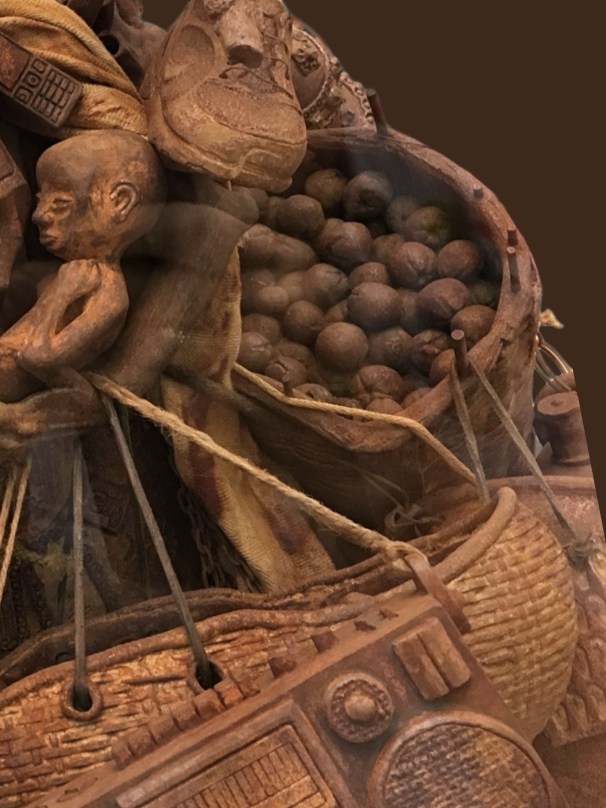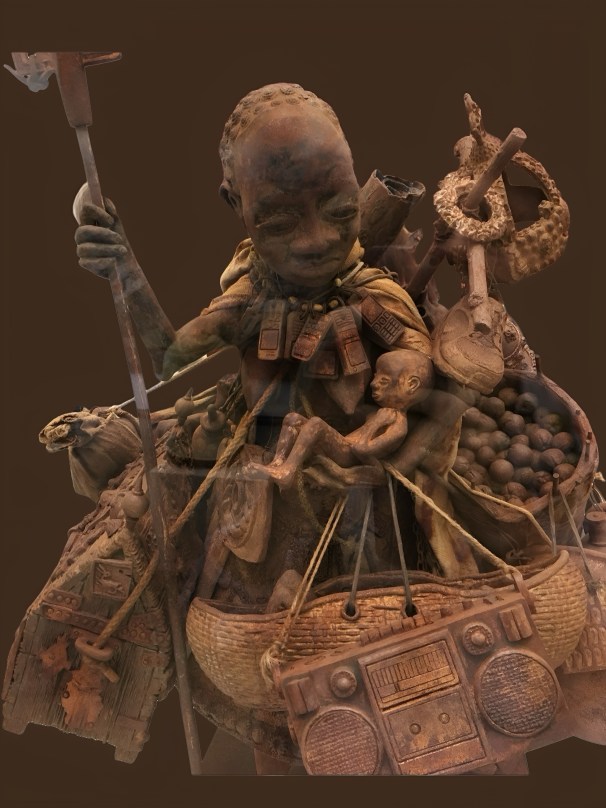A Mouth Full of Salt; Debut Novel by Reem Gaafar
A Review in Wartime

Our Mother, Grayson Perry, 2009. Photo by Imogen Thurbon.
Reem Gaafar’s A Mouth Full of Salt is a celebration of Afro-Arab and African womanhood. It is also a plea for mutual cultural understanding at a time when ethnic and religious identities are once more pitched against each other, to devastating effect. This week’s post is dedicated to this remarkable novel.

Setting the Scene
Then and Now; The Novel’s World
Southern Sudanese Life in Northern Sudan; A Painful Legacy
Setting the Scene; The Author and The Novel
The Author


Above, author, physician, researcher, Sudanese feminist, film maker and documenter of the 2029 Sudanese popular uprising, Reem Gaafar. Her debut novel, A Mouth Full of Salt won The 2023 Island Prize for African Literature. Reem has described writing as her constant life companion and started writing at the age of thirteen.

While steeped in the western literary canon, it was the works of writers such as Leila Aboulela and Jamal Mahjoub who spoke to her of her own world, giving her “a sense of belonging”, who most inspire her (Afrocritik). She says it is the “injustices in the world and how ordinary people do extraordinary things” that drive her work (Afrocritik). Keenly aware of our own complicity in injustice, she also acknowledges with hope our power to bring about change (500 Words).
Reem Gaafar’s writing has appeared in African Arguments, African Feminism, Teakisi Magazine, Andariya and 500 Words Magazine, among others. Her short story ‘Light of the Desert’ was published in I Know Two Sudans (Gipping Press UK, 2014) where it was awarded an Honourable Mention. Her short story ‘Finding Descartes’ was published in Relations: An Anthology of African and Diaspora Voices (HarperVia, 2023). Saqi Books A Mouthful of Salt. Read an excerpt from the opening section of the novel in Excerpt Brittle Paper Read about Reem’s creative writing process and the genesis of the novel in Tint Journal
The Novel – Themes

Above the Karima ferry approaching Dongola, late 1980s, Imogen Thurbon. The river Nile, capricious and kind by turn, is both backdrop to the events of the novel and protagonist.
A Mouth Full of Salt charts with contagious energy the interlacing destinies of three Sudanese women across four decades spanning late condominium rule to the Jaafar Numeiri years. As would be expected from an author who confesses she is “irritated” by women portrayed solely as passive victims of circumstance, the protagonists of A Mouth Full of Salt drive this novel forward at a compelling pace, as they navigate their own course through the societal constraints of village life in 1980s northern Sudan. In the process, they clash headlong with matriarchs, themselves endowed with terrifying agency, intent on imposing their own understanding of what constitutes decent society. As the story unfolds, wounds inflicted decades before bleed into the present, exposing the fragility of notions of honour, respectability, and “racial purity”. Certainties unravel and a terrible price is exacted for past cruelties in which all are implicated.
“Just give them a son. Then you will be safe.” “Safe from what? Sulafa had asked.
Then and Now; The Novel’s World

Meroe, mid-1980s, Imogen Thurbon.

From early to late 1980s I worked as a girls’ secondary school teacher in a bustling northern Sudanese town. There I was accepted with immeasurable kindness and a generosity that I will forever be grateful for. My time then in Sudan coincided with the political vicissitudes of the latter years of the Numeiri regime.

In the school staffroom, carefully non-committal comments were ventured on the president’s newfound enthusiasm for political Islam, the imposition of Sharia under the September Laws and reports of amputations in Khartoum prisons. Many of my colleagues described the recent public execution of Islamic reformer Mahmoud Taha as a necessary correction of religious deviancy. The re-igniting of the Sudanese civil war had brought in its wake the mass migration of southern Sudanese to the north, some of whom ended up in our town, eking out a living as servants and cleaners.
I remember still the arrival in my school of ten South Sudanese girls who had been sent to the north on a government sponsored educational exchange. As the tall, desperately thin young girls entered the room where I happened to be teaching, the class erupted in screams of fright, some genuine, some performative, and much nervous adjusting of hijabs. Later I was to learn from southern Sudanese in the town that they were often still referred to in Arabic as “slave”, were banned from openly practising their faith and secretly conducted church services under trees in wasteland outside the town. It is this world that is the dark backdrop to Reem Gaafar’s tale.
Above, scenes from Northern Province, 1980s; Delgo village and a Dongola doorway.

A Mouth Full of Salt opens with Fatima perched high above her village, a visual eavesdropper onto the streets, courtyards and river banks below. She follows the progress of her fellow villagers hurrying to relieve diving parties searching for a missing boy, presumed drowned. As Fatima watches their efforts, she traces the “incomplete copy of the village she had known her whole life”, sprawled below her, “with large chunks of it missing here and there, like a messily amputated leg”. Her village, like so many others, had been decimated in the 1988 floods and her family too was haunted by the loss of loved ones to The Nile.
Left, scenes from Northern Province, late 1980s.
Fatima, the bird’s eye observer, yearns for a life beyond her village horizons “where marriage conferred status” and stepmothers are “the gatekeepers to marriage proposals”. She “pictured herself simmering away in the heat of her own tukul – or actually her in-laws’ one since they would be living with Sadig’s parents – stirring at the large pots, sweating and blinking from the smoke of the burning branches. She would be wrapped in her jersey tob, her gold bracelets jangling noisily, surrounded by her neighbors who would gather around during the day to drink herbal tea and gossip. …None of this interested her.”

With Fatima, we step into into Reem Gaafar’s intense and vivid recreation of northern village life four decades ago; perfuming and henna ceremonies for young brides taken out of school too soon, young girl’s dreams of a university education in the capital, enmities and unexpected kindnesses between co-wives united in the agonies of childbirth, death as an everyday casual presence, and rumours of sorcery and the evil eye.
For more on Sudanese wedding customs see Anointing in Robes of Red and Gold Karkar, Dilka and Dukhan “ A Open Hand will Encounter Henna” Hair Braiding in Northern Sudan
While you can read similarly vivid evocations of period village life in Hammour Ziada’s The Drowning and Hamid Dirar’s The Amulet, Reem Gaafar brings the acuity and intimacy of a woman’s gaze to this world, to striking and often chilling effect. Secrets with the power to destroy are shared among women in their kitchens of packed earth floors and palm-fronded roofs. Precious wedding clothes are hidden away from envious eyes and mothers bereft of their child become “mothers of none”.
Although Ziada and Dirar relate the brutal slitting open of women’s bodies in childbirth at a time when FGM was rigorously practised, their descriptions are second-hand, at a distance. Reem Gaafar brings the crude violence upon women’s bodies to us, their labour pains, their loss, the vulnerability of their status, as perhaps only a woman and a woman physician can. Male and female agency are seen here through women’s eyes; ironic, witty and often rueful as the author ponders to what extent Sudanese society has truly changed and what debts are yet to be repaid.
Above, detail from Our Mother, Grayson Perry.
Southern Sudanese Life in Northern Sudan; A Painful Legacy
“At the top of the hill, she slowly turned around to observe the village spread out beneath her, down to the gardens and the river. The river was like a bit of string, following her through time and place, anchoring her here – to a village that she hated with all her heart – but also moving her along.”

Interwoven with Fatima’s destiny is that of Nyamakeem, a southern Sudanese woman who had married a man from Fatima’s village several decades before. Her story is informed, but not defined by, the legacy of a colonial policy profoundly detrimental to the South, the centuries-old enslaving of southern Sudanese by their northern neighbours, and the realities of a racism that has endured long after the abolition of slavery in Sudan.
In making Nyamakeem a central – some may say the central character of the novel, Reem Gaafar enters painful and still controversial territory as a northern Sudanese writer and filmmaker; territory courageously explored in Goodbye Julia, Heroic Bodies Our Beloved Sudan, and by writers such as Dirar and Ziada. In an interview with Saqi Books, Reem spoke movingly of her determination to honour southern Sudanese standpoints and experience, and her lengthy research undertaken with South Sudan colleagues while writing the novel. See comments by Francis Deng.
Ultimately a Mouth Full of Salt reveals how a simple act – the heartfelt acknowledgement of mutual loss by those estranged by race, custom or history, can restore humanity. How cruelty, when inflicted within a community however small still has the capacity to fester, distort and poison far beyond village walls. How the community holds within its hands the means to restore itself. And how the world she so vividly evokes still exists and informs the Sudan at war today. At this time of great tragedy for Sudan the novel speaks to all who hope for a kinder future for a wonderful country.
Above, Our Mother, Grayson Perry.
For more on Sudanese women writers, see Malikah ad-Dar – Trailblazer.

